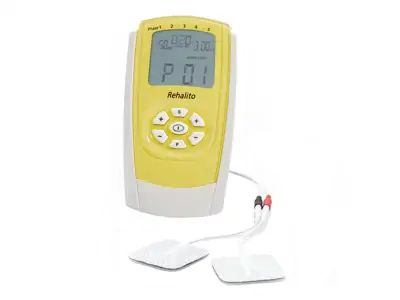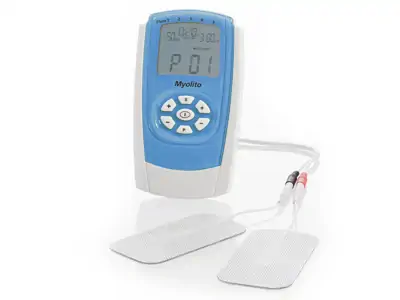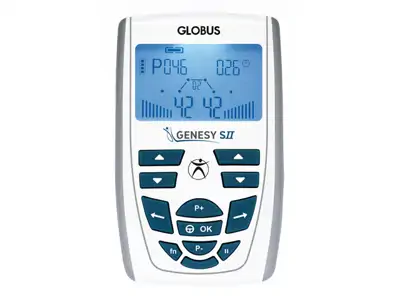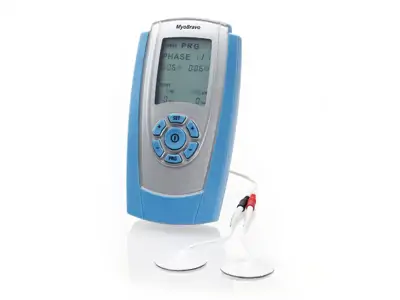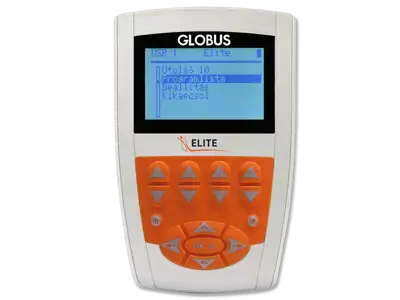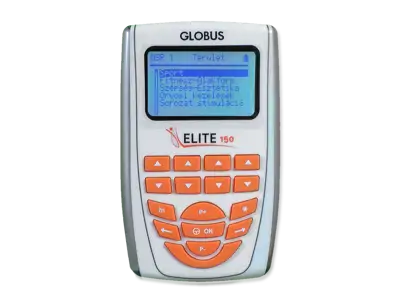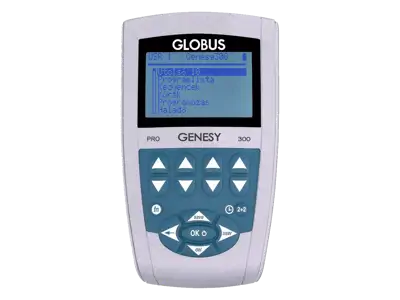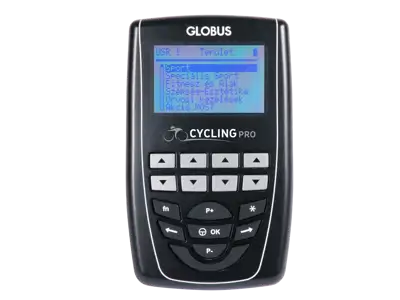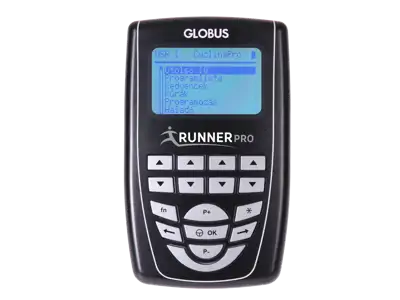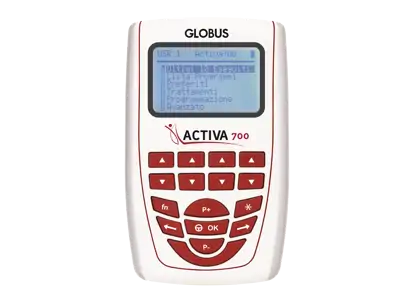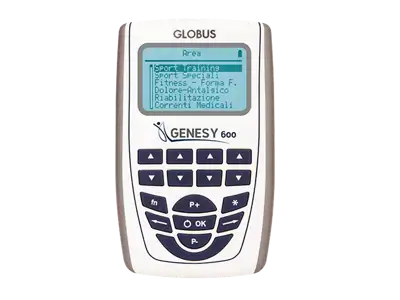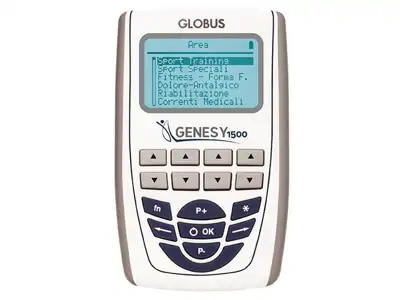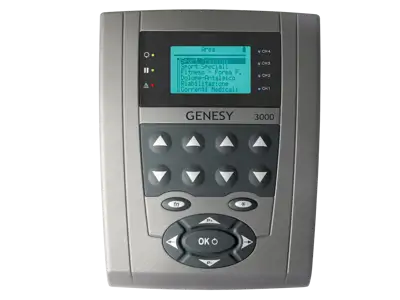Electric Muscle Stimulator (EMS)
Muscle stimulator is a device for athletes and people with muscle and joint diseases that affects muscle mass and muscle performance.
Read more...The Muscle Stimulator is a muscle stimulation device that
- is an effective treatment for a wide range of muscle and joint disorders, and a
- doping-free performance enhancement method for professional and amateur athletes alike!
In a short time, it increases muscle strength and muscle mass. This is why it has been used in physical therapy for decades.
In sports it is mainly used to improve muscle fibre-specific abilities such as endurance, speed or even reaction speed. Clinical studies have demonstrated that muscle stimulation stimulates the elimination of metabolites (lactic acid, CK, etc.) accumulated during exercise and is therefore highly recommended to improve muscle recovery after any physical activity.
Muscle stimulation is not to be misunderstood! In sport, muscle stimulation is a supplement to exercise, not a replacement for it. It is therefore worth using it regularly and incorporating it into your training programme.
What is an electrical muscle stimulator?
A muscle stimulator is a device used to perform muscle stimulation, or electric muscle stimulation (EMS).
A tiny electrical impulse is delivered to a muscle and causes it to contract. The effect is the same as physical exercise: muscle fibres change in size, strength, metabolism and blood flow.
The procedure has been used in medicine for decades to rehabilitate sports injuries, but only in the last few years have effective and affordable home versions appeared.
Muscle stimulators are safe to use as long as you follow the "rules of the game", but to get the real results, it doesn't hurt to know what you're doing and why!
Key parameters of the muscle stimulation pulse
The properties of the stimulation pulse (intensity, frequency, pulse amplitude, duration, rise and decay times) influence the intensity and depth of the muscle contraction, the type and number of fibres involved in the contraction. It follows that the desired progress can only be achieved with a properly adjusted pulse rate.
Frequency
is the number of pulse cycles per second, expressed in Hertz.
A pulse with a higher frequency targets the transient and fast fibres, while a lower frequency targets the slow fibres
Amplitude
Amplitude is a value expressing the duration of the pulse. Its unit of measurement is the microsecond (ms).
Each muscle has a different amplitude. Smaller bulky muscles can be contracted with a shorter impulse, while the largest muscles (quadriceps, broad back muscles) require a longer impulse duration.
Intensity
- Intensity is a user-adjustable measure of the electrical current, measured in milliAmps (mA).
- The higher the value, the more muscle fibres are involved in the contraction. In other words, low intensity means few fibres, high intensity means many fibres.
- If the treatment is "not felt", it has no effect, while too high an intensity can trigger a spasmodic contraction and cause pain.
- When it comes to muscle stimulation, you usually don't need to go above the pain threshold!
- The intensity of the stimulation pulse required to achieve artificial muscle contraction varies from person to person.
- It also depends on the position of the electrodes, the amount of underlying fat tissue, sweating, the amount of hair on the treated surface and other characteristics.
- Therefore, the same current intensity can produce different sensations from day to day, which can vary from person to person.
- It is also necessary to regulate the intensity during a given training session, by maintaining the same level of contraction and allowing the body to adapt.
Positioning of electrodes
The positioning of electrodes for muscle stimulation is different from that used for TENS, analgesic treatments. Correct electrode positioning is also a prerequisite for the effectiveness of the treatment.
Position the electrodes at the motor point that is sensitive to stimulation!
If the electrode is not positioned at the motor point, the contraction may be slight/disturbing. In this case, you should move the positive electrode a few millimetres to achieve an effective and comfortable contraction.
You may feel at a loss when you first try the muscle stimulator. But fear not, it works despite a complete lack of accuracy!
But understanding a few basic principles of placement will go a long way to helping you use the stimulation properly.
If you're aiming for perfection, however, buy a motor point pencil. This will help you to map the exact point where the muscle-motor nerve meets. Once you have that, there's nothing to stop you from getting the perfect treatment.
Electrode position
One electrode should be placed on the most bulging part of the muscle. This is also called the active electrode, because the bulging part of the muscle usually coincides with the motor point, the point where the nerves enter the muscle. For example, in the outer part of the quadriceps femoris (vastus lateralis), the bulging part of the muscle is located a few centimetres above and below the knee.
The other electrode, called the inactive electrode, is placed at the proximal (towards the trunk) end of the muscle. Both electrodes should stay on the fleshy part of the muscle! There are no nerve endings from the part where the muscle continues in the tendon. Tighten the muscle you want to treat and palpate along it! Determine how far it is "soft" and where it goes into a tendon. Place the electrodes only on the muscle.
Anatomical features vary from person to person, and calves are a great example: some people have elongated and thin muscles, while others have short and round ones.
High-quality devices come with diagrams like this one, which illustrate electrode placement. If you "mimic" this, you shouldn't have too much trouble. If you're still not satisfied with the effect, experiment! Move one electrode left and right, up and down a few mm and observe the effect. You'll soon find out which point works best for you.
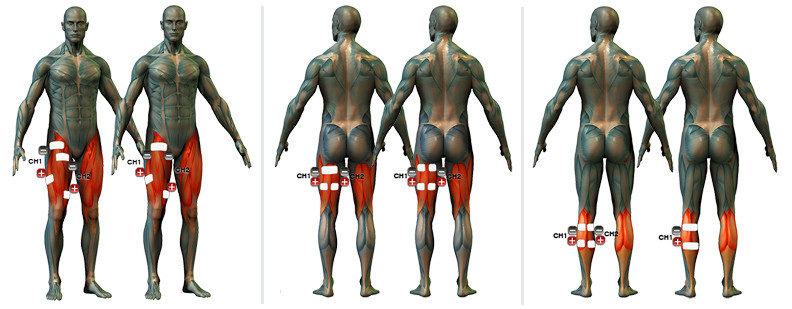
If you run the electrode transversely instead of along the length of the muscle fibre, the resistance increases and the treatment is uncomfortable, so you don't get a strong enough contraction.
Can I hurt myself with muscle stimulation?
I would definitely dare say that you have to be very careless! The instruction manual for each device lists the dangers of not using muscle stimulation.
For example, if you are using a pacemaker device, do not place the electrode on your chest as it may stop the pacemaker - which could result in your death. But that's like saying don't plug a nail into an electrical socket... On the other hand, if the pacemaker is going to treat the thigh muscle, there is no danger.
Back to top...